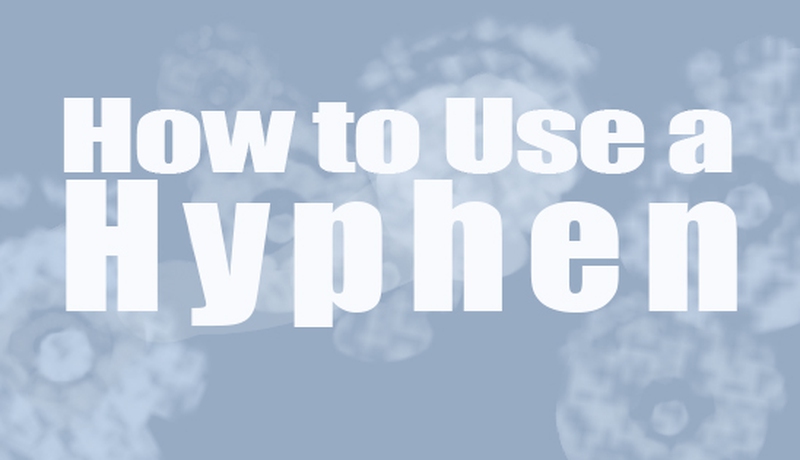You see them almost every day, yet, when it comes to how to use a hyphen correctly, you would be amazed at the number of people who pause in confusion. Fear no longer! After reading this article, never again will you pause in indecision when faced with a potential hyphen.

What Is a Hyphen?
What Exactly Is It?
Ok, so what exactly is a hyphen? The Oxford dictionary defines a hyphen as, “The sign (-) used to join words to indicate that they have a combined meaning or that they are linked in the grammar of a sentence.” It’s actually simpler than it sounds. Words that “have a combined meaning” are generally compound adjectives, AKA, two or more words that, when combined, form a describing word. When placed before a noun (a word used to identify a person, place or thing), they are known as “compound modifiers” and they get a hyphen. An example would be “long-term relationship”, because “long” and “term” each have separate meanings, but when you combine them together (“long-term”) they form a new meaning.
Why Do You Need Them?
Why is it necessary to know how to use a hyphen correctly? Well, hyphens change the meaning of a sentence. The popular twitter account @GrammarMonkeys sums it up in this way, “Because a violent weather conference isn't the same as a violent-weather conference.” Do you see the difference? Without a hyphen, that sentence is describing a weather conference that became violent. With a hyphen, it describes a conference on violent weather.
How to Use a Hyphen Correctly
Compound Adjectives
As already stated, a hyphen is needed to join two or more describing words that are used before a noun.
Correct usage:
a one-way street
state-of-the-art design
Incorrect usage:
the chocolate covered nuts
Remember though, that when compound modifiers come after a noun, they are not hyphenated.
Correct usage:
The nuts were chocolate covered.
The street was one way.
Incorrect usage:
The design was state-of-the-art.
Compound Numbers
You also need to use a hyphen when writing a compound number.
Correct usage:
There are twenty-three questions.
The house was fifty-six years old.
Incorrect usage:
They played forty two games.
Avoiding Confusion
Sometimes a hyphen is necessary to avoid confusion caused by an awkward combination of letters.
Correct usage:
re-sign your name (different than if you were to resign from a job)
semi-independent (but semiconscious would not require a hyphen)
Incorrect usage:
shelllike (but childlike would not require a hyphen)
Prefixes and Suffixes
Hyphens are used with prefixes (like ex-, all- or self- or between a prefix and a capitalized word), suffixes (such as –elect) and with figures or letters.
Correct usage:
ex-wife
mid-September
Incorrect usage:
mayor elect
Line Break Between Syllables
Sometimes you will find that a line of text does not have enough space for a full word at the end of the line, so a hyphen may be used to divide the last word. Only put the hyphen between syllables.
Correct usage:
prefer-ence (line break after the hyphen)
individ-ualist (line break after the hyphen)
Incorrect usage:
indi-fferent
Line Breaks on Words with Existing Hyphens
Another rule for line breaks applies to words that are already hyphenated. In this case, the line break would occur at the existing hyphen.
Correct usage:
mass-produced
self-reliant
Incorrect usage:
well-kn-own
Line Breaks on Words Ending with -ing
If you need to use a line break on a word ending in -ing, you would hyphenate at the suffix itself (in between the root word and the -ing), unless the final consonant in the root word is doubled (such as in ‘planning’ or ‘running’). In this case, you would put the hyphen between the doubled consonants.
Correct usage:
plan-ning
driv-ing
Incorrect usage:
runn-ing
Line Breaks That Leave Only One Letter
Finally, never make a line break that leaves only one letter or either line, or in the case of a two letter suffix, such as "lovely", and don’t begin the new line with the two letter suffix.
Correct usage:
lov-ely
evalu-ate
Incorrect usage:
slow-ly
Difference Between a Hyphen and a Dash
What Is a Hyphen?
Like explained above, a hyphen is the shorter mark, which does not have a space on either side of it.
For example:
part-time
back-to-back
What Is a Dash?
A dash is the longer mark that is used as a form of punctuation in a sentence. They are used to set apart and emphasize a particular part of a sentence. Picture a dash like a mental stop sign. The writer wants you to literally “hold that thought” and briefly consider something else. For example:
My grandmother – who is the strongest woman I know – gave me sound advice.
This family holiday – the first in over ten years – was to be a special occasion.

View All Comments /Add Comment